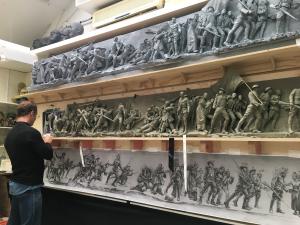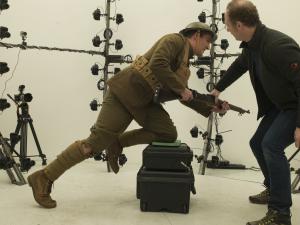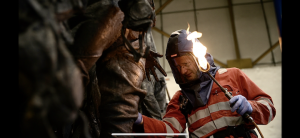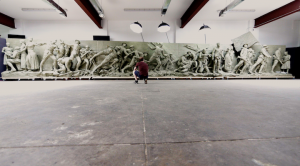Entertainment - Media News Watch originally published at Entertainment - Media News Watch
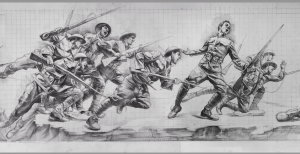
Master Sculptor Sabin Howard had no idea he would invent an entire manufacturing process to create the largest free-standing relief in the Western hemisphere.
— Sabin Howard
KENT, CT, UNITED STATES, September 5, 2024 /EINPresswire.com/ — Master sculptor Sabin Howard heard of the design competition for the National WWI Memorial in the summer of 2015. A friend who admired his work phoned him. The friend said, “You must enter this competition! The world needs to see your work!”
Sabin Howard had no idea he would ultimately have to invent an entire manufacturing process to create the largest free-standing relief in the Western hemisphere.
Howard initially entered the competition with an architect out of Texas. Howard designed a sculpture of two soldiers that stood in the light from an oculus in a Pantheon-like rotunda.
Their design was not selected for the final round. Howard somehow knew that he wasn’t finished with the competition. He told his wife, “I’m not one of the five finalists, but this will come back to me.”
In fact, talented 25-year-old architect-in-training Joe Weishaar advanced into the final round. He needed a sculptor and emailed Howard in September, 2015. Weishaar had designed a long wall with a relief for Pershing Park. The World War I Centennial Commission liked the design because it maintained the urban park design. They told him, “You need a sculptor.”
Weishaar combed the website for the National Sculpture Society, perusing sculptor websites. He came upon Howard’s website listed, incorrectly, in the “S” section, as if ‘Sabin’ was his last name. Weishaar had found his sculptor. Weishaar wrote, “I urge you to join me on this historic venture.”
In January, 2016, Howard and Weishaar won the competition with a design initially called “The Weight of Sacrifice.” Weishaar worked for several years to design the park.
Sabin Howard went on to design, create, and sculpt “A Soldier’s Journey,” the sculptural heart of the new National WWI Memorial Park.
Sabin Howard’s first step was to design the composition of the relief. He purchased original WWI uniforms, hired young actors out of Brooklyn, built a platform on which they posed, and took over 12,000 photographs in his South Bronx studio. Those photographs were rendered into 25 iterations before the composition was finalized.
During the photography, Howard drew the compositions. Howard is not only a Renaissance-quality sculptor, he is also a master draughtsman. He sees drawing as the foundation of art; he used the drawings to work out his composition. It took him hundreds of hours over nights, weekends, and holidays to accomplish his drawings.
This intensive pace was just the beginning of his marathon.
When Howard achieved a drawing approved by the World War I Centennial Commission as well as the various interested Washington, DC agencies, he was faced with a new problem: how to turn his drawing into a three-dimensional maquette, or model, to show the sculpture.
The project was languishing at this moment. The WWICC, with only a drawing to show donors, was about to fold up their tents. Howard was determined not to let that happen. He found Weta Workshop in New Zealand, a special effects and prop company that specialized in turning designs into reality for Hollywood movies.
Applying for a grant from a foundation he knew, Howard raised a half million dollars, left his family, and took his drawing to New Zealand to do just that.
With Weta, Howard created several foam print-outs of “A Soldier’s Journey.” He needed to work out the correct depth for the relief. He realized that the sculpture had to be in high relief, with several figures fully in the round, for the sculpture to make a visceral impact on the viewer.
Howard had been tasked with creating a sculpture that, like Shrady’s Grant Memorial by the Capitol, was dynamic and evocative. He was told that it had to interest people in the Great War, the War to End All Wars, in which more than 116,000 Americans and some 20,000,000 + Europeans died.
Howard intended to create a sculpture that was sacred art. He intended to show reverence for the plight of veterans, who return from war damaged both physically and mentally—or who never return at all. These brave souls from WWI, and from all wars, deserve honor and remembrance.
Howard was also determined to make the statement that beauty, excellence, and the artist’s skill matter. He had a masterwork ahead of him. It had to be amazing. He was fully committed.
Howard returned from New Zealand with a 10’ long maquette featuring 38 figures. These figures tell the story of a doughboy leaving his wife and daughter, hearing the call to join his brothers-in-arms, entering into the mad frenzy of battle, suffering the tragic cost of war with fallen brothers and his own shellshock (now called post traumatic stress), and then returning home to his daughter, victorious but transformed.
The doughboy’s daughter, the alpha and omega of the sculpture, is the next generation. She looks into the helmet and divines what is to come: World War II.
Howard’s composition is his take on the classic Hero’s Journey described by Joseph Campbell. It is a tale ubiquitous to cultures throughout the world, and it says something poignant and fundamental about the human condition and our need to go forth and grow. We must fully engage with the great adventure of our lives to become actualized—even though the voyage costs us dearly.
Howard’s figures are not just specific individuals, they are also an allegory for the United States. The Heroic Mom, figure 4, is reluctant to let her husband go to war, just as the United States was reluctant to enter the conflict and send its people overseas.
The Commission on Fine Arts in Washington, DC, asked for some changes. In particular, CFA wanted the sculpture shrunk down to 58’ in length to match the distance between potted plants in the park.
Howard muttered about how the landscape architects on the CFA didn’t understand sculpture, but he pushed his figures closer together, achieving a tighter interweave. It was, he says, inspired by Michelangelo’s “Last Judgement,” which shows all of humanity pretzeled together.
Howard then had to figure out how to take a maquette and turn it into a heroic scale, 10’ high, 58’ long sculpture. He was loath to use digital tools, believing that an artist works with his head, his heart, and his hands: his physical person. But the WWICC was not going to wait for the twenty-five years required by such an ambitious project.
At this time, Howard was searching for a skilled foundry to cast the sculpture into bronze. He needed a manufacturing process that would meet his exacting standards.
Via an Instagram post by British sculptor Nick Bibby, Sabin Howard learned of Pangolin-Editions Fine Arts Foundry in Stroud, UK.
Howard emailed Pangolin and, within a week, flew to England. Located on the grounds of the foundry, he discovered an intricate 160 camera photogrammetry rig created by Steve Russell of Steve Russell Studios.
Howard realized that the photogrammetry rig could greatly reduce the timespan of his sculpting process. He was going to have to marry his gorgeous hand-sculpted figurative art with the digital process that would make it executable within a relatively short period of time.
In January, 2019, Howard took a team of models to Stroud. He dressed them in original uniforms and period clothing and posed them inside the photogrammetry rig. All 160 cameras went off at the same moment, and this digital imagery was fed into a program called Z-brush.
Howard sat alongside the Z-brush technicians and worked shoulder-to-shoulder with them to render the digital imagery into his vision of the final sculpture. The information generated by Z-brush was used to mill out CNC foam figures. The foam was coated with a thin layer of clay; these milled-out figures would serve as super-accurate armatures on which Sabin and his team could sculpt. They were not art, not yet. They were blank like mannequins in a department store window, waiting the master’s hand.
This was more than four years into the creation of “A Soldier’s Journey” and Sabin Howard hadn’t yet picked up a sculpting tool! He was chafing to do so. And now he had only four and a half years to finish.
Finally, by August, 2019, the first set of figures were ready to be sculpted by Howard. He assembled a team of sculptors including Charlie Mostow from Seattle. They set to work in a light-filled new studio in Englewood, NJ.
Within the year, the strictures of the pandemic tightened their grasp on the world. The mold-makers of Pangolin were scheduled to fly to New Jersey to mold the first 11 of Sabin’s finished clay figures, now exquisitely sculpted, to make the molds on site in the studio. That was no longer possible.
Once again, Sabin Howard faced a thorny challenge.
With both trepidation and courage, Howard decided to ship his finished clay figures overseas. This is never done: sculptors NEVER ship finished clays. It’s too easy to damage the surface and lose all the work.
Howard’s wife Traci Slatton, working as his project manager and documentarian, booked a refrigerated shipping container for the transatlantic voyage. It had to be refrigerated so the clay surface wouldn’t melt.
Howard and his friend carpenter Mario Monti created an internal carapace, inside the container, to secure the finished clay figures. They developed a system for cushioning the figures, chopping off limbs, and strapping them to the hand-made skeleton, so the figures wouldn’t move inside the container.
Howard sent over the 38 figures in five shipments. In all that time, thanks to Howard’s and Monti’s careful build within the containers, only two figures were damaged: Heroic Mom’s ear was smooshed when she pitched forward, and the finger of Flag Guy (Figure 34) broke.
In January, 2024, meeting his deadline, Sabin Howard shipped over the last group of five figures. His work wasn’t done, however. He spent time at the Foundry in the spring and summer of 2024, overseeing metalwork, assembly, and patination.
In August and September, 2024, under the broiling sun, Howard worked on site in Washington, DC, overseeing the assembly of “A Soldier’s Journey” in its final home on our shores, applying the final patina, and participating in the lighting design to showcase this magnificent memorial at night.
On September 13, 2024, at dusk, Sabin Howard will speak at the Illumination Ceremony that inaugurates his masterwork. This ceremony will be attended by dignitaries, senators, and celebrities and it will also be webcast. Sabin Howard especially hopes that veterans will watch from Freedom Plaza, where Jumbotron screens and speakers will broadcast the ceremony.
As Howard told Mike Rowe in his beloved “The Way I Heard It” podcast, “I stand for an art that is for the people… Art is for…we the people because it’s supposed to help people come together under an umbrella.”
Rebecca DeSimone, Esquire
Sabin Howard Sculpture LLC
[email protected]
Visit us on social media:
X
LinkedIn
Instagram
YouTube
Other
Sizzle Reel for “HEROIC”
Legal Disclaimer:
EIN Presswire provides this news content “as is” without warranty of any kind. We do not accept any responsibility or liability
for the accuracy, content, images, videos, licenses, completeness, legality, or reliability of the information contained in this
article. If you have any complaints or copyright issues related to this article, kindly contact the author above.
![]()
Originally published at https://www.einpresswire.com/article/740982993/nation-s-capital-celebrates-masterpiece-from-classical-sculptor-who-invented-a-process-for-the-design
Entertainment - Media News Watch originally published at Entertainment - Media News Watch

